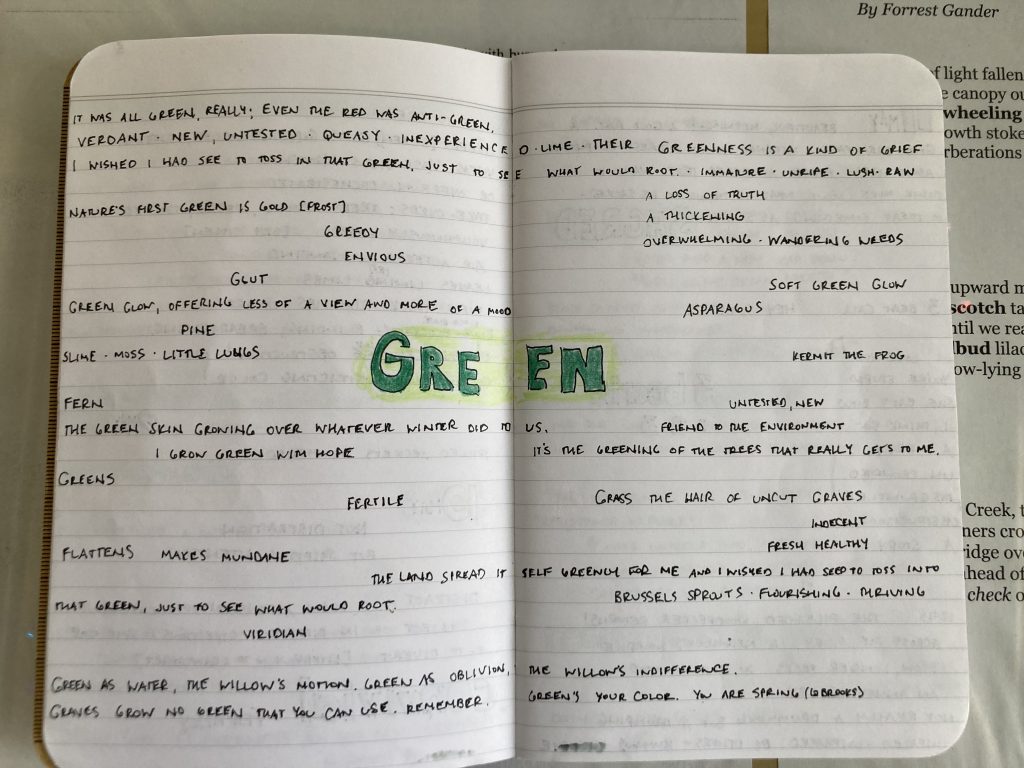4.2 miles
longfellow garden and back
73 degrees / dew point: 75
Sticky again today, but not as bright. Still hard to run through the thick air. Struggled on the way back — walk run walk run. Trying to remember to keep showing up and believing that it will get easier, or I will get better at handling the difficult moments, or I will finally start getting up early. I tried to think about green.
my favorite green
Running south, just past the ford bridge, nearing the locks and dam no. 1, cool air was coming from the green to my right — a small wood. Refreshing! Often I associate late spring green with thick and stifling, but today it was fresh and generous, making it easier to breathe and to run.
Before my run, I read this green poem:
Making Life on a Palette/ Raina J. León
After Charles Willson Peale (1741–1827), “George Washington at Princeton,” 1779
the color of life
takes sun yellow and bluest blue sky and water
for green ferns
chartreuse buds beading above moss
dappled shamrocks
fragrant healing of sage, laurel,
mint, basil, thyme, rosemary, myrtle
amid the tall wonders of juniper
pine, olive, pear
even the meeting of sea and river—
the sky, an intermingling of viridian and chetwode horizons,
and cerulean clarity—
offers its green seafoam,
its seaweed pats,
the crocodile at the edge of a freshwater marsh
its teeth open gritted in green
against the backdrop of hunter rainforest
dripping in green
heaven is a field of persian green
lit by translucent jade and celadon lamps
a many-roomed chateau scented by aromatic tea leaves
the aperitivo: gin, apple, and bitter lime
the time: midnight green
the guardian: a mantis in prayer
joy: harlequin, verdun, spring
magic: kaitoke forest in its energetic whisper and pulse
green must exist
inside brother james
would he call it camouflage
or nyanza or sap
for washington it’s in the colors of flags
the fields far off
feldgrau or military or empire green
or dollar bill or rifle green
revolution with chains the result
mix the green
like a spell in making
safe life
hush arbor life
nurturing abundant life
free life
bring the background to the fore
ease
ease
ease
life
So many greens! How many different greens can I see? Today, mostly, it was just green (or brown or gray).
Offering some advice on being judicious with your use of adjectives, Ted Kooser writes the following lines:
Morning Glories/ Ted Kooser
We share so much. When I write lattice,
I count on you seeing the flimsy slats
tacked into squares and painted white,
like a French door propped in a garden
with a blue condensed from many skies
pressed up against the panes. I count on
you knowing that remarkable blue,
shaped into the fluted amplifying horns
of Edison cylinder record players.
What? Come on, you know exactly
what I’m talking about. I didn’t need
to describe them like that, but I like to
however a little over my words, dabbling
the end of my finger in the white throats
of those __. You fill it in.
I could go on, but all I really needed to do
was to give you the name in the title.
I knew you’d put in the rest, maybe
the smell of a straw hat hot from the sun;
that’s just a suggestion. You know exactly
what else goes into a picture like this
to make it seem as if you saw it first,
how a person can lean on the warm
hoe handle of a poem, dreaming,
making a little more out of the world
than was there just a moment before.
I’m just the guy who gets it started.
Do I know that remarkable blue he’s writing about? Does he see the same blue that I do? Do we need to imagine the same blue to make his poem meaningful?
Reading “Making Life on a Palette” and “Morning Glories,” I’m thinking about the different work they ask of the reader, or, of this reader, me. “Palette” is filled with green words with histories that I don’t know; I had to do a lot of googling to dig into the poem. “Morning Glories” asks me to build an image from the name he offers, to draw upon the shared understanding/image of the flower that I already have.
Lately, I keep coming back to the question, how little data can we have and still “see” what something is? Not much, I think. Yet, to assume that we all see the same thing — the thing as it is — excludes a wide range of experiences and detail and ways of seeing. It leaves out a lot of different shades of green.
Speaking of green, I remembered that I had collected ideas about green in my plague notebook vol 3, June 2020:
